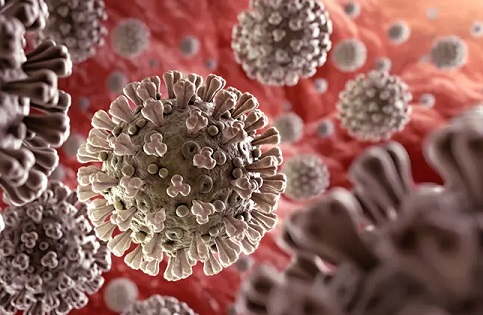Nikhil Prasad Fact checked by:Thailand Medical News Team May 18, 2025 7 months, 6 days, 5 hours, 39 minutes ago
Medical News: A breakthrough study reveals how syntaxin 6 plays a critical role in fighting SARS-CoV-2 infection
A team of Chinese scientists has made a significant discovery that could help the world better understand how the COVID-19 virus enters and spreads in the human body. The study, conducted by researchers from the Wuhan Institute of Virology, the State Key Laboratory of Virology, the University of Chinese Academy of Sciences, the Guangzhou Laboratory, and the School of Basic Medicine at Henan University, has found that a protein naturally present in our cells called syntaxin-6, or STX6, can actually stop SARS-CoV-2 from infecting cells.
 New Cellular Protein Could Help Block COVID-19 Virus Entry into Cells
New Cellular Protein Could Help Block COVID-19 Virus Entry into Cells
This
Medical News report explains that even though COVID-19 is no longer classified as a global emergency, the virus is still circulating, evolving, and causing health problems. While much is already known about how the virus binds to cells and gets in through receptors like ACE2, scientists were unclear about what happens inside the cell after the virus enters. That’s where this new study makes a major contribution.
The role of syntaxin 6 in viral defense
Syntaxin-6 is a type of SNARE protein involved in the internal traffic system of the cell. It helps move different substances between compartments inside cells. Using a method called proximity labeling, the researchers identified which proteins surround the ACE2 receptor after infection. They found that syntaxin-6 interacts with incoming virus particles and redirects them away from areas where the virus can escape into the cell, and instead sends them into a special “garbage disposal” system known as the autophagy-lysosomal pathway.
In simpler terms, once the virus sneaks into a cell, syntaxin-6 grabs it and reroutes it to a compartment where the cell can destroy it before it has the chance to start replicating and causing damage. When researchers removed STX6 from cells using gene-silencing techniques, they noticed a much higher level of viral replication. Conversely, when STX6 was added back into the cells, the virus was significantly suppressed.
Works across variants and even other viruses
The study revealed that STX6 is effective not just against one variant but many strains of SARS-CoV-2 including Delta and Omicron subvariants such as BA.2, BA.5, and XBB.1.9. Even more impressively, it also showed antiviral activity against other endocytosis-using viruses like Enterovirus A71, Vesicular Stomatitis Virus (VSV), and Hepatitis C Virus.
The researchers confirmed that STX6 works by preventing the virus from leaving the early endosomes—the compartments that the virus uses after entering cells. Instead of allowing the virus to mature and escape into the cell to begin replicating, STX6 pushes it into autophagosomes, which eventually merge with lysosomes to break down the viral particles.
STX6’s antiviral function is evolutionarily conserved
Another major f
inding is that the antiviral function of STX6 appears to be conserved across species. STX6 from mice and bats, which are common models for studying SARS-like viruses, showed similar protective effects. This suggests STX6 may be part of a universal defense system that evolved to protect against viruses entering through endocytosis.
Conclusion and future directions
In conclusion, the discovery of syntaxin-6’s ability to block viral escape and promote degradation via the autophagy pathway highlights a promising new direction in COVID-19 research. Understanding how the human body naturally uses proteins like STX6 to defend itself could pave the way for new antiviral therapies. Researchers believe that enhancing this natural mechanism could help prevent not only COVID-19 but other viral infections that exploit the same entry method. More research is still needed to uncover how exactly STX6 is recruited during infection and whether it can be targeted safely for future treatment strategies.
The study findings were published in the peer reviewed Journal of Virology.
https://journals.asm.org/doi/10.1128/jvi.00002-25
For the latest COVID-19 News, keep on logging to Thailand
Medical News.
Read Also:
https://www.thailandmedical.news/news/mitochondrial-flux-and-its-disruption-in-viral-infections-such-as-covid-19
https://www.thailandmedical.news/news/covid-19-causes-disruptions-in-blood-brain-barrier-via-mitochondria-impairment-and-endothelial-dysfunction
https://www.thailandmedical.news/news/genetic-clues-reveal-how-covid-19-may-trigger-ischemic-stroke-risk
https://www.thailandmedical.news/articles/coronavirus
https://www.thailandmedical.news/pages/thailand_doctors_listings
